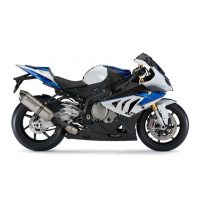Brake system with
BMW Motorrad Race
ABS
Partially integral brakes
Your motorcycle is equipped with
partially integral brakes. Both
front and rear brakes are applied
when you pull the handbrake
lever. The footbrake lever acts
only on the rear brake.
The integral braking func-
tion makes it very difficult
to spin the rear wheel by opening
the throttle with the front brake
applied to keep the motorcycle
stationary (Burn Out). Attempted
burn-outs can result in damage
to the rear brake and the clutch.
Do not attempt a Burn Out un-
less the ABS function has been
switched off.
How does ABS work?
The amount of braking force that
can be transferred to the road
depends on factors that include
the coefficient of friction of the
road surface. Loose stones, ice
and snow or a wet road all have
much lower coefficients of friction
than a clean, dry asphalt surface.
The lower the coefficient of fric-
tion, the longer the braking dis-
tance.
If the rider increases braking
pressure to the extent that brak-
ing force exceeds the maximum
transferable limit, the wheels start
to lock and the vehicle loses its
directional stability; a fall is im-
minent. Before this situation
can occur, ABS intervenes and
adapts braking pressure to the
maximum transferable braking
force, so the wheels continue
to turn and directional stability
is maintained irrespective of the
condition of the road surface.
What are the effects of
surface irregularities?
Humps and surface irregular-
ities can cause the wheels to
lose contact temporarily with the
road surface; if this happens the
braking force that can be trans-
mitted to the road can drop to
zero. If the brakes are applied
under these circumstances, the
ABS has to reduce braking force
to ensure that directional sta-
bility is maintained when the
wheels regain contact with the
road surface. At this instant, the
BMW Motorrad Integral ABS
must assume an extremely low
coefficient of friction, so that the
wheels will continue to rotate un-
der all imaginable circumstances,
because this is the precondition
for ensuring directional stability.
As soon as is registers the ac-
tual circumstances, the system
reacts instantly and adjusts brak-
7
117
z
Engineering details

